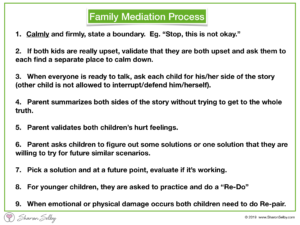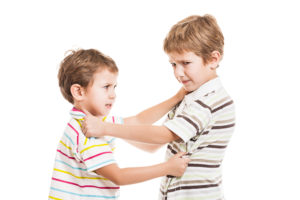What are the Roots of Sibling Rivalry?
According to Alfred Adler, one of the founding fathers of depth psychology (along with Freud and Jung), siblings are “striving for significance” within the family. Siblings compete with each other for parental involvement and attention.
For the oldest child who experiences the birth of a new baby brother or sister, they become dethroned by this new addition to the family. Think of this scenario taken from the excellent book, Siblings Without Rivalry by Adele Faber & Elaine Mazlish: (*for the Dads reading this please substitute the word “husband” for “wife”)
Imagine that your spouse puts an arm around you and says, “Honey, I love you so much, and you’re so wonderful that I’ve decided to have another wife just like you”….When the new wife finally arrives you see that she’s very young and kind of cute. When the three of you are out together, people say “hello” to you politely, but exclaim ecstatically over the newcomer. “Isn’t she adorable? Hello sweetheart…You are precious!” They they turn to you and ask, “How do you like the new wife?” Then the new wife needs clothing. Your husband goes into your closet, takes some of your sweaters and pants and gives them to her. When you protest, he points that since you’ve put on a little weight, your clothes are too tight on you and they’ll fit her perfectly! (p.36-37)
What would be your reaction?! This gives you a context for how the competition of sibling rivalry begins.
Understanding Brain Chemistry When the Brain is in Fighting Mode
When the brain receives input from our five senses that it is “under attack”, the thinking part of our brain (the Prefrontal Cortex) shuts down and the Emotion Centre/Alarm Centre (The Amygdala) takes over. Our instincts take us to fight, flight or freeze. When siblings are arguing or fighting, they are no longer able to think reasonably.
Remind yourself of my quote: “Feelings First, Logics Last”
Feelings First
At this time it is best to offer both children time apart to calm down and/or the parent can talk to them both and validate their feelings. By validating the right-brain feelings of both children, without taking sides no matter what happened, the Amygdalas of all will calm down.
For example: “Woah I can see that you are both really upset. For you to be hitting/yelling at each other, I can see that you’re both mad/hurt (fill in the feeling). You both need to find a separate place to calm down and take some deep breaths and then we can talk about it all together.”
*If the children are angry, it is positive if they can move to tears and/or feelings of sadness. This keeps their hearts soft and more open to attachment – relationships with each other as well as with you, the parent.
After the parent has facilitated the process of validating both children’s feelings (even if it seemed to be one-sided – it’s really important to stay NEUTRAL and validate both children), and everyone is calm enough to have a discussion, one can then move into left-brain problem solving.
Logics Last … Problem Solving
Firstly, the parent needs to role model self-regulation – a calm approach to problem-solving.
Next, both children need to feel heard and understood.
First, each child is asked to share their side of the story and the other child is not allowed to interrupt. Once one child has shared their side of the story, the other child then shares their side of the story and again the other child is not allowed to interrupt. The purpose of each child sharing is so that they feel heard NOT for the parent to try and figure out the truth as there’s always three truths! The truth as seen/felt by each child and the actual truth.
The parent then re-states what each of the children say without taking sides.
The parent summarizes both sides of the story and acknowledges that this is a difficult situation, yet there are family rules that apply under all circumstances. For example, we don’t hit each other in our family and we don’t use rude words towards each other. We all feel angry sometimes and that’s okay to tell someone that you’re really mad at them, but not to swear at them.
The parent then discusses the various choices for resolution.
The siblings may choose to:
- Problem-solve themselves but with a parent overseeing
- Problem-solve with a parent also giving suggestions for how they could do things differently in future
You can help them evaluate their solutions that they suggest, by wondering aloud what the solution would look like.
Depending on the age of the children, you may then have them do a “Re-Do” and role play the scene that led to the conflict but this time, implement the newly agreed on solution.
Most important is that a solution is chosen that they are willing to try!
If emotional damage (harsh words) or physical damage (hitting, kicking) occurred during the conflict, then it’s important to have the children engage in repair also thought of as re-pair (pair up again). Making amends is the goal of the repair process and a very important life long skill. To read more about RE-PAIR, read my previous article on this topic here and in Teaching My Child How to Apologize.
If either of your children are feeling too defensive or hurt to repair, or if you simply don’t have time to have them do it at that moment, then be sure to hold them accountable later.
Remind yourself it’s okay to wait until later as long as you follow-up. If your defensive child is refusing to participate in the repair process, then you can drop the topic for now but later when your child starts asking you for favours such as a playdate or being driven somewhere, you can use the “When – Then” strategy and say:
“Sure, when you’ve done repair (or made amends) with your sister/brother, then I can take you to….”
This is not a threat – it’s a logical sequence of events. We all have to repair damage to move forward and so your child needs to repair damage and then move on.
Why Does This Sibling Conflict Resolution Process Reduce Sibling Rivalry?
This process decreases sibling rivalry because you are not “taking sides”. The moment a parent starts taking one child’s side, the other child feels angry and resentful (even if they were the initial aggressor) and this anger and resentment fuels the sibling rivalry even more.
Think of family mediators and how important it is for them to stay neutral and observational versus “take sides” and be emotional. When helping siblings resolve conflict, it’s essential to remain neutral, no matter how hard that can be.
The key is to return responsibility to your children! You are not there to save them and rescue them. You are there to guide them, coach them and teach them the life-long skill of conflict resolution.
If one child is sobbing, you can still comfort that child and stay neutral. How? You can ask both children to come to you and you can put an arm around each one of them while stating that you can see that they are both upset.
To access the downloadable pdf below, that you could stick to the inside of a kitchen cupboard, stating the sibling conflict resolution steps, click here.

Hope this helps you all to have a cooperative family week,
Warmly,
PS. To help your child (ages 5-10) with worries, you may wish to purchase my children’s book/parental resource: Surfing the Worry Imp’s Wave.
Want to Connect?
Subscribe now to receive free weekly parenting tips and inspiration.








